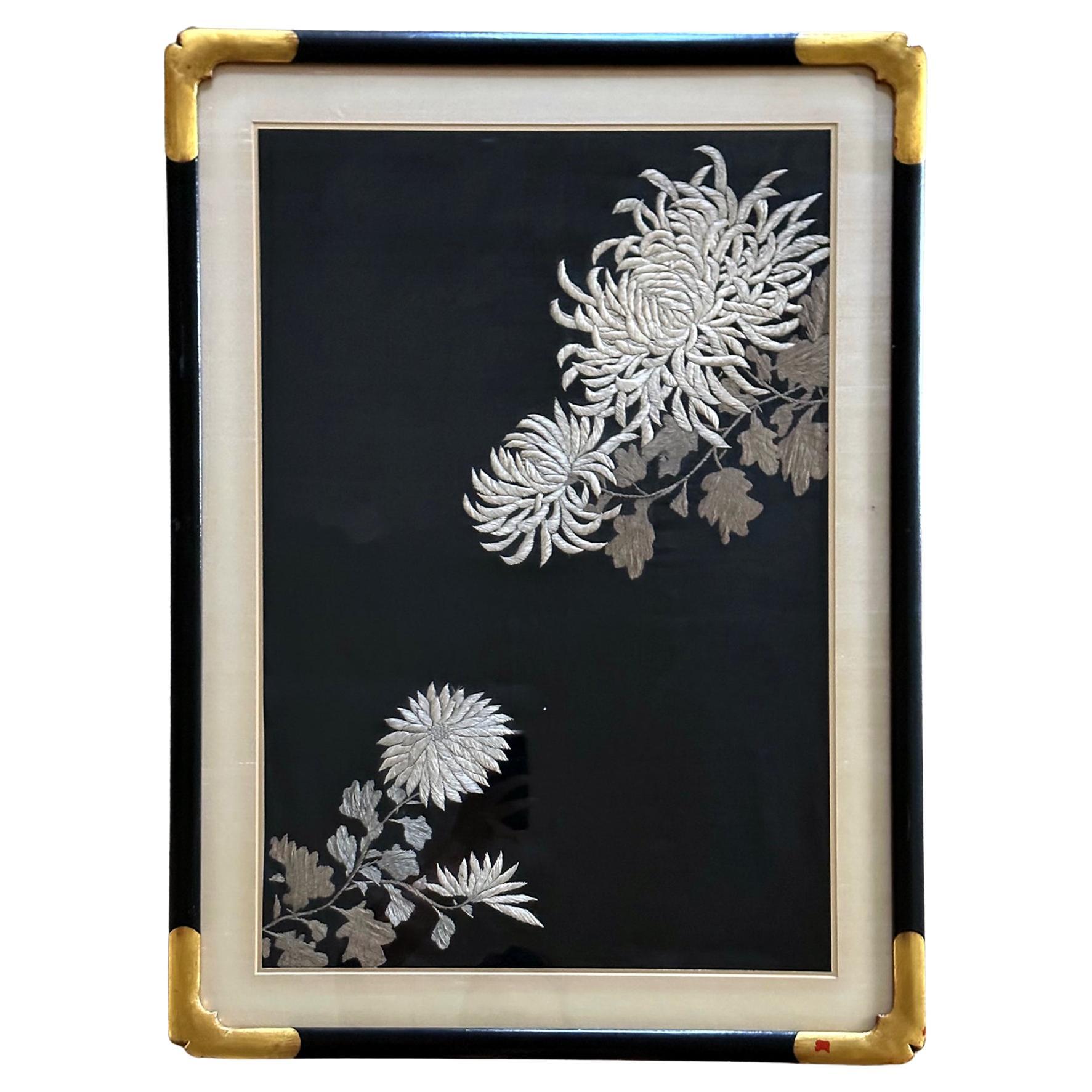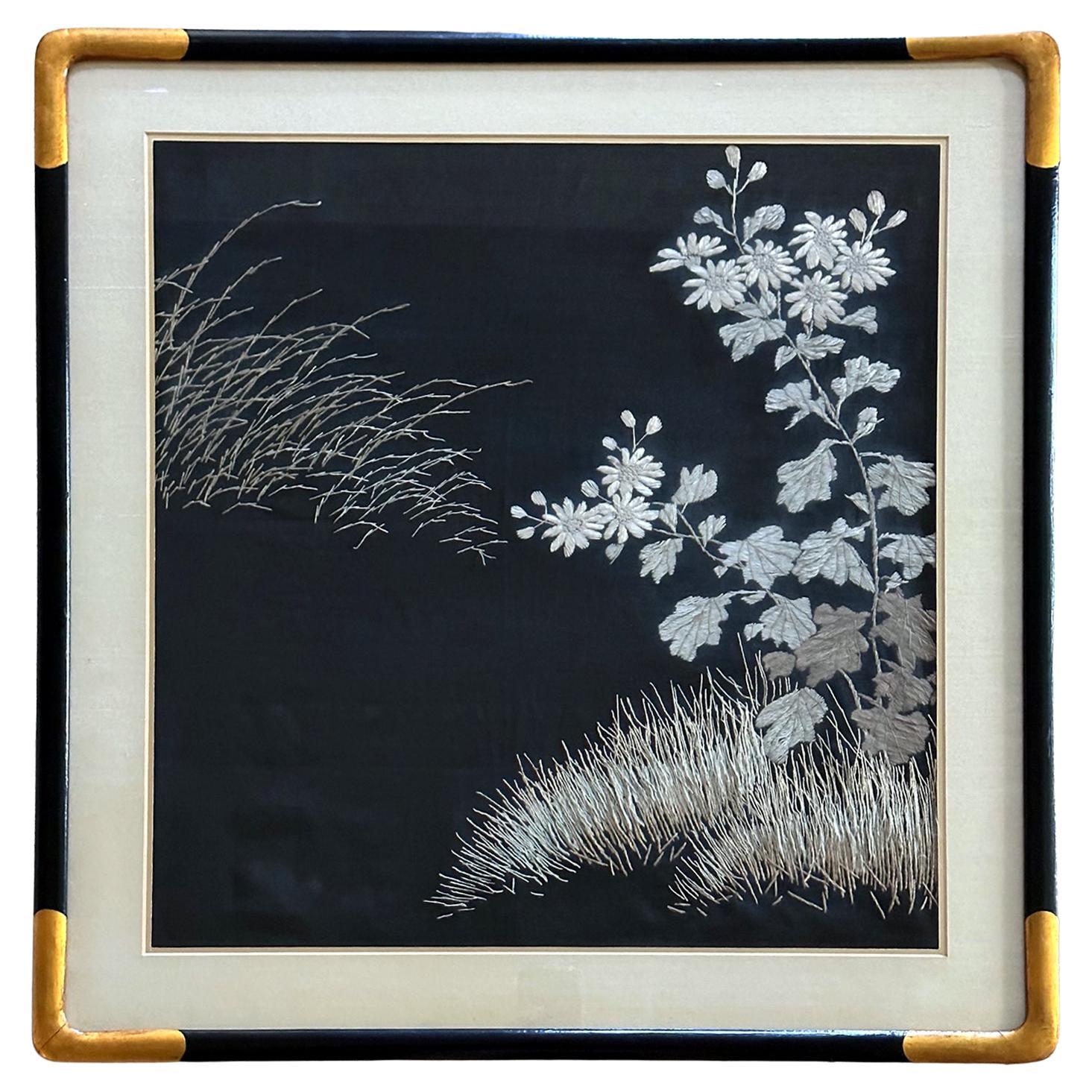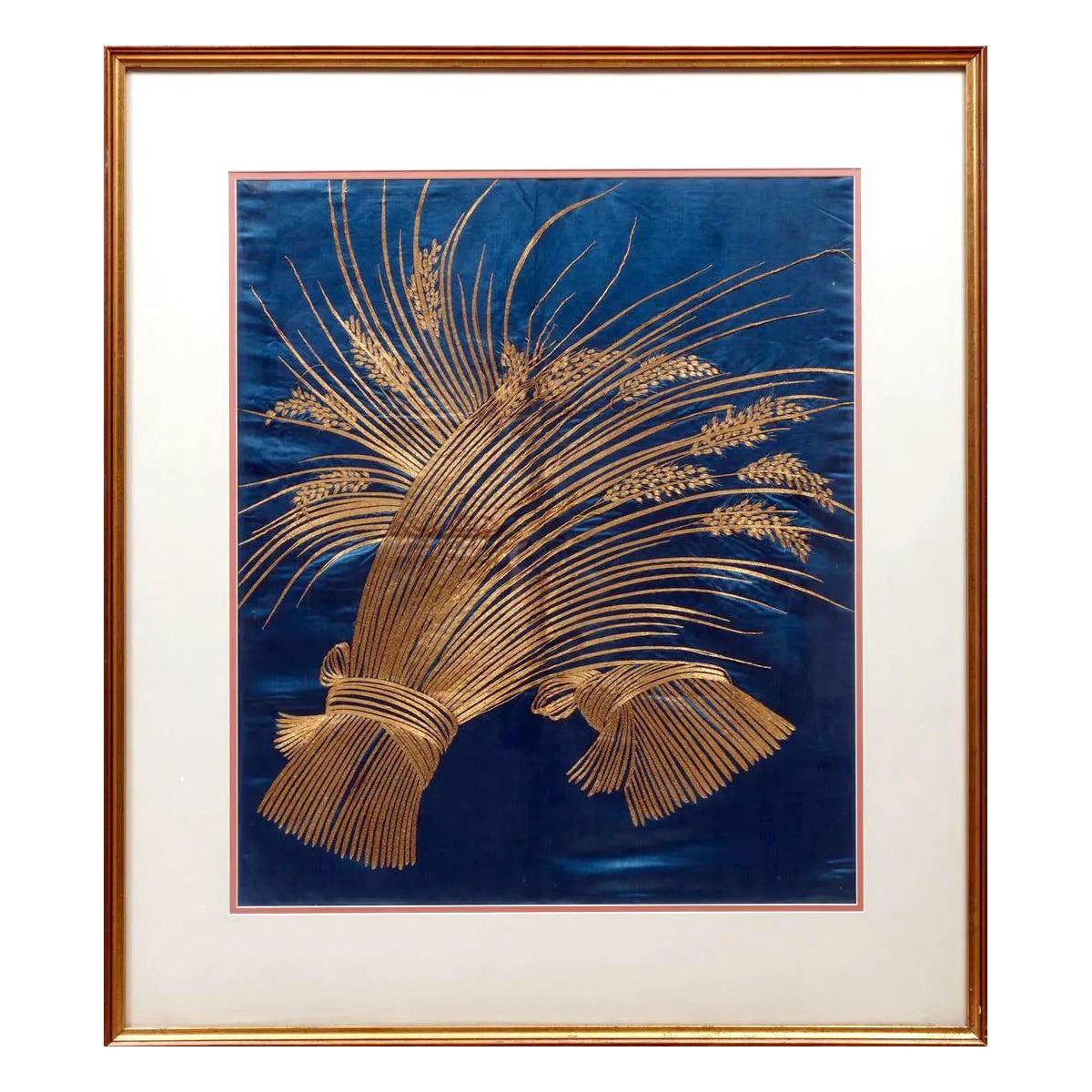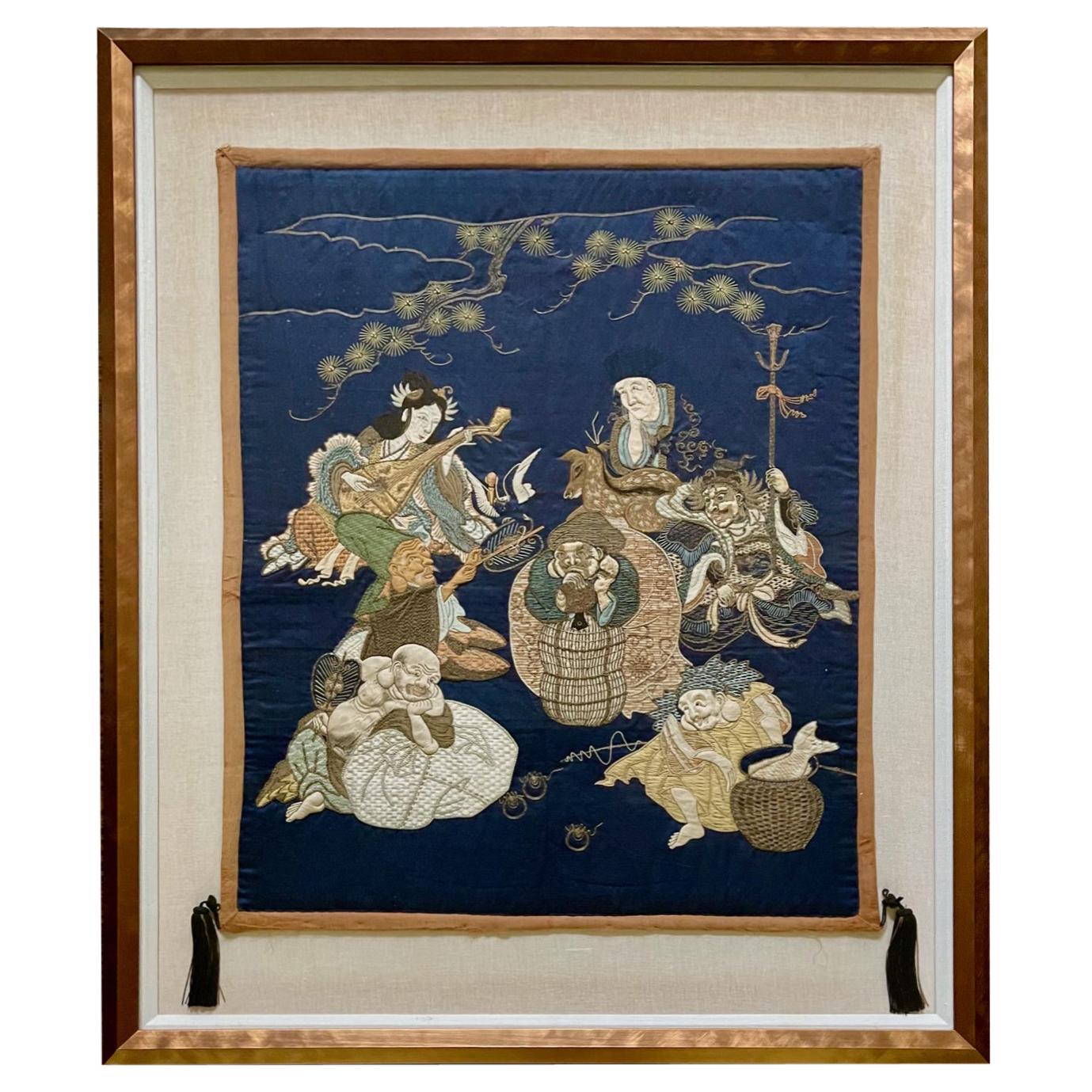Items Similar to Japanese Asian Framed Meiji Peroid Silk Floral Flower Embroidery Textile Panel
Want more images or videos?
Request additional images or videos from the seller
1 of 14
Japanese Asian Framed Meiji Peroid Silk Floral Flower Embroidery Textile Panel
About the Item
A beautiful and wonderfully designed/composed Japanese textile panel with embroidery floral natural landscape/flower decoration. The work is presented in a gilt wood frame with a silk mat and gold leaf corners. The ultra-fine needlework is quite special. The centerpiece flower design features what was referred to as "blind knots" or "forbidden knots" as they are meticulously and intricately done.
This piece was created during the early Meiji period (1868-1912) and comes from the Beverly Hills estate/designed home of 1930s American actor/interior designer William (Billy) Haines.
Would be a great addition to any Japanese or Asian art/artifacts/textile collection or make for an eye-catching stand-alone accent piece in about any setting.
Framed dimensions: 32.5" High, 16.25" Wide, 1" Deep
- Dimensions:Height: 32.5 in (82.55 cm)Width: 16.25 in (41.28 cm)Depth: 1 in (2.54 cm)
- Style:Meiji (Of the Period)
- Materials and Techniques:
- Place of Origin:
- Period:
- Date of Manufacture:19th Century
- Condition:In very good to excellent vintage condition with bright bold colors. The frame may have light wear consistent with age and use (please see photos). Beautiful and engaging overall.
- Seller Location:Studio City, CA
- Reference Number:1stDibs: LU2254337517002
About the Seller
4.9
Platinum Seller
These expertly vetted sellers are 1stDibs' most experienced sellers and are rated highest by our customers.
1stDibs seller since 2016
770 sales on 1stDibs
Typical response time: <1 hour
- ShippingRetrieving quote...Ships From: Studio City, CA
- Return PolicyA return for this item may be initiated within 7 days of delivery.
More From This SellerView All
- Japanese Asian Oshie Pressed Textile Old Monk Framed Shadow Puppet DollLocated in Studio City, CAA wonderful, handcrafted work of a Japanese monk/ old man doll shadow puppet who appears to be making an offering of some sort. Oshie, which translat...Category
Mid-20th Century Japanese Showa Sculptures and Carvings
MaterialsTextile, Linen, Acrylic, Wood
- Japanese Asian Large Meiji Period Silk Embroidery Peacock Bird Flower TapestryLocated in Studio City, CAA stunning Meiji Period (1868-1912) Japanese large framed embroidery/ tapestry featuring a pair of finely detailed birds - likely peacocks in a floral garden landscape. A truly magn...Category
Antique 19th Century Japanese Meiji Tapestries
MaterialsSilk, Glass, Wood
- Japanese Oshie Pressed Textile Samurai Framed Showa Shadow Puppet DollLocated in Studio City, CAA wonderful, handcrafted work of a regal Japanese samurai/warrior doll shadow puppet. Oshie, which translates as pressed pictures, is a traditional Ja...Category
Mid-20th Century Japanese Showa Sculptures and Carvings
MaterialsTextile, Linen, Acrylic, Wood, Paper
- Japanese Buddhist Monk Priest 7 Column Silk Brocade Kesa Ceremonial Temple RobeLocated in Studio City, CAA wonderful, beautifully ornamented and somewhat rare fully intact Japanese Buddhist monk/ priest's Kesa ceremonial silk robe featuring various colorful birds in flight. Kesa (which came from the Chinese word "kasaya") robes have been handmade/handstitched by monks/priests as an act of devotion as ceremonial robes for centuries in various Asian cultures (Japanese, Chinese, Korean, Vietnamese, Indian, etc.). The kesa is a rectangular garment designed to be worn over the left shoulder (see example image). The robes are made (often in a patchwork column pattern ranging from five, seven, nine or more pannels) specifically for fully ordained Buddhist monks, priests and nuns and are made from donations of exquisite textiles from wealthy patrons of Japanese Buddhist temples. The robes were used in daily ceremonies, temple gatherings, and private meditation. Antique Kesa robes...Category
Mid-20th Century Japanese Showa Textiles
MaterialsTextile, Brocade, Silk
- Japanese Edo Buddhist Monk Priest 7 Column Silk Brocade Kesa Ceremonial RobeLocated in Studio City, CAA wonderful, brightly coloured and somewhat rare fully intact Japanese Buddhist monk/ priest's Kesa ceremonial silk robe. Kesa (which came from the Chinese word "kasaya") robes have been handmade/handstitched by monks/priests as an act of devotion as ceremonial robes for centuries in various Asian cultures (Japanese, Chinese, Korean, Vietnamese, Indian, etc). The kesa is a rectangular garment designed to be worn over the left shoulder (see example image). The robes are made (often in a patchwork column pattern ranging from five, seven, nine or more pannels) specifically for fully ordained Buddhist monks, priests and nuns and are made from donations of exquisite textiles from wealthy patrons of Japanese Buddhist temples. The robes were used in daily ceremonies, temple gatherings, and private meditation. Antique Kesa robes...Category
Antique 19th Century Japanese Edo Textiles
MaterialsTextile, Brocade, Silk
- Japanese, Signed Stamped Silk Obi Sash Belt with Temple Shrine, Mid-1900sLocated in Studio City, CAA wonderful handmade vintage silk obi sash / belt featuring a Japanese temple - purportedly Kiyomizu temple in Kyoto, among the forest trees. Signed a...Category
Mid-20th Century Japanese Showa Textiles
MaterialsSilk
You May Also Like
- Framed Japanese Embroidery Textile Panel Meiji PeriodLocated in Atlanta, GAA Japanese textile panel with embroidered picture work circa late Meiji period (1900s) presented in a gilt wood frame with silk mat. The work de...Category
Antique Early 1900s Japanese Meiji Textiles
MaterialsSilk, Wood
- Framed Japanese Embroidery Textile Panel Meiji PeriodLocated in Atlanta, GAA Japanese textile panel with embroidery needlework circa late Meiji period (1900s) presented in a gilt wood frame with silk mat. The work depic...Category
Antique Early 1900s Japanese Meiji Textiles
MaterialsSilk, Wood
- Framed Japanese Embroidery Silk Panel Meiji PeriodLocated in Atlanta, GAA Japanese silk embroidery Fukusa panel presented in mat and glazed gilt wood frame circa 1890-1910s (end of Meiji Period). The blue silk pane...Category
Antique 1890s Japanese Meiji Textiles
MaterialsSilk
- Framed Antique Japanese Silk Embroidery Fukusa Textile PanelLocated in Atlanta, GAA Japanese Fukusa Panel with tassels displayed in a gilt frame circa Meiji Period. Fukusa is a traditional Japanese textile art used as a...Category
Antique Late 19th Century Japanese Meiji Textiles
MaterialsSilk, Wood
- Framed Antique Japanese Embroidery Fukusa Textile PanelLocated in Atlanta, GAA Japanese silk Fukusa Panel housed in a gilt frame circa late 19th century of Meiji Period. Fukusa is a traditional Japanese textile art used as a wrap for presenting gifts at important occasions. On the deep blue background, the elaborate embroidery work depicts three deities of the Shichifukujin (Seven Gods of Fortune...Category
Antique Late 19th Century Japanese Meiji Textiles
MaterialsSilk, Wood
- Framed Antique Japanese Embroidery Fukusa Textile PanelLocated in Atlanta, GAA Japanese silk Fukusa Panel housed in a gilt frame circa late 19th century of Meiji Period. Fukusa is a traditional Japanese textile art used as a wrap for presenting gifts at important occasions. On the deep blue background, the elaborate embroidery work depicts a historical scene where street vendors selling goods to a royal household or an aristocratic residence. The scene focuses on the activities at the front gate where the couriers and servants were busying carrying the goods in. A peasant with straw coat...Category
Antique Late 19th Century Japanese Meiji Textiles
MaterialsSilk, Wood
Recently Viewed
View AllMore Ways To Browse
Asian Antique Art
Japanese Gold Leaf Flowers
Suzani Decor
1900 Silk Wedding Shawl
Antique Indian Textiles Gujarati
Antique Leather Mughal Raj Ottoman Moorish Shoes
Vintage Handmade Gujarati Tribal
Palampore Textile India
Hand Embroidered Kimono
Bottega Small Basket
Thai Silk Bag
Khmer Textile
Embroidered Bed Spread
Embroidery Americana Patriotic Silk
Japanese Silk Embroidered Birds Framed
Qing Dynasty Wedding Jacket
Spanish Flamenco Shawl
Sumatra Embroidery





